BACK TO HOME PAGE
WEEK 17
INVENTION, INTELLECTUAL PROPERTY, AND INCOME
WEEK ASSIGNMENTS:
Tasks for a week
- Individual assignment: develop a plan for dissemination of your final project prepare drafts of your summary slide (presentation.png, 1920x1080) and video clip (presentation.mp4, 1080p HTML5, < ~minute, < ~10 MB) and put them in your root directory
Final Project:
My final project is smart adjustable desk. I built a scissor table with a DC gear motor to assist me with vertical positioning. An Arduino controller, a motor driver, and an Android smartphone app are used to make changes to my project. I use an ultrasonic sensor to measure height and display the results on a 2*16 LCD display.
What is Intellectual Property ?
Intellectual property (IP) refers to creations of the mind, such as inventions; literary and artistic works; designs; and symbols, names and images used in commerce. IP is protected in law by, for example, patents, copyright and trademarks, which enable people to earn recognition or financial benefit from what they invent or create. By striking the right balance between the interests of innovators and the wider public interest, the IP system aims to foster an environment in which creativity and innovation can flourish
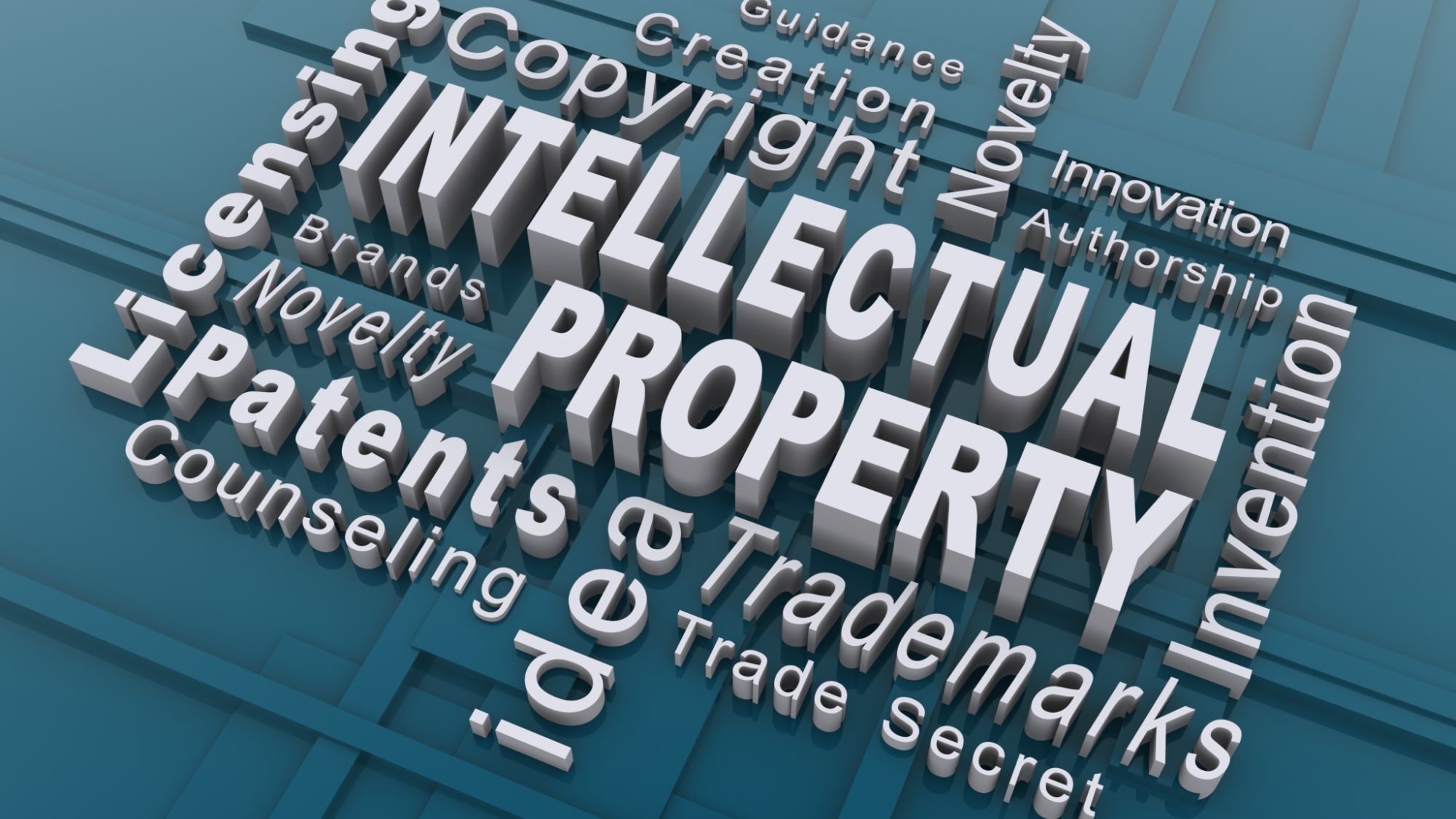
What is an Invention ?
An invention is a research result that potentially can be commercially exploited. The invention can be patented if it meets patent law criteria for patentability. A patent is a form of ownership of the invention (a legal document) that protects the invention and patent holder. It gives the patent holder the right to prevent or allow others to exploit the invention for a limited period, typically 20 years
Open Source License
An open-source license is a type of license for computer software and other products that allows the source code, blueprint or design to be used, modified and/or shared under defined terms and conditions. This allows end users and commercial companies to review and modify the source code, blueprint or design for their own customization, curiosity or troubleshooting needs.
Open-source licensed software is mostly available free of charge, though this does not necessarily have to be the case. Licenses which only permit non-commercial redistribution or modification of the source code for personal use only are generally not considered as open-source licenses.
However, open-source licenses may have some restrictions, particularly regarding the expression of respect to the origin of software, such as a requirement to preserve the name of the authors and a copyright statement within the code, or a requirement to redistribute the licensed software only under the same license (as in a copyleft license).
One popular set of open-source software licenses are those approved by the Open Source Initiative (OSI) based on their Open Source Definition (OSD).
To learn about types of open sourse licences I referred to these websites
Apache licenses
The Apache License is a permissive free software license written by the Apache Software Foundation (ASF).The Apache License, Version 2.0 requires preservation of the copyright notice and disclaimer. Like other free software licenses, the license allows the user of the software the freedom to use the software for any purpose, to distribute it, to modify it, and to distribute modified versions of the software, under the terms of the license, without concern for royalties. This makes ALv2 a FRAND-RF license. The ASF and its projects release the software they produce under the Apache License and many non-ASF projects are also using the ALv2.
The GNU General Public License
The GNU General Public License (GNU GPL or GPL) is a widely used free software license, which guarantees end users the freedom to run, study, share and modify the software. The license was originally written by Richard Stallman of the Free Software Foundation (FSF) for the GNU Project, and grants the recipients of a computer program the rights of the Free Software Definition. The GPL is a copyleft license, which means that derivative work can only be distributed under the same license terms. This is in distinction to permissive free software licenses, of which the BSD licenses and the MIT License are widely used examples. GPL was the first copyleft license for general use. GNU Lesser General Public License The GNU Lesser General Public License (LGPL) is a free software license published by the Free Software Foundation (FSF). The license allows developers and companies to use and integrate software released under the LGPL into their own (even proprietary) software without being required by the terms of a strong copyleft license to release the source code of their own components. The license only requires software under the LGPL be modifiable by end users via source code availability. For proprietary software, code under the LGPL is usually used in the form of a shared library, so that there is a clear separation between the proprietary and LGPL components. The LGPL is primarily used for software libraries, although it is also used by some stand-alone applications.
The MIT
The MIT License is a permissive free software license originating at the Massachusetts Institute of Technology (MIT). As a permissive license, it puts only very limited restriction on reuse and has, therefore, an excellent license compatibility. The MIT license permits reuse within proprietary software provided that all copies of the licensed software include a copy of the MIT License terms and the copyright notice. The MIT license is also compatible with many copyleft licenses, such as the GNU General Public License (GPL); MIT licensed software can be integrated into GPL software, but not the other way around
creative commons
A Creative Commons (CC) license is one of several public copyright licenses that enable the free distribution of an otherwise copyrighted work. A CC license is used when an author wants to give people the right to share, use, and build upon a work that they have created. CC provides an author flexibility (for example, they might choose to allow only non-commercial uses of their own work) and protects the people who use or redistribute an author’s work from concerns of copyright infringement as long as they abide by the conditions that are specified in the license by which the author distributes the work
Going through these different licenses, such as MIT License, I got the feeling that it is too general, not really protecting what I want, that is why not suitable for me . In the case of GNU Lesser General Public License (LGPL), this license is more for software. I came up with my decision about the license that I want . I choose creative commons Attribution-NonCommercial 4.0 International (CC BY-NC 4.0) following these steps
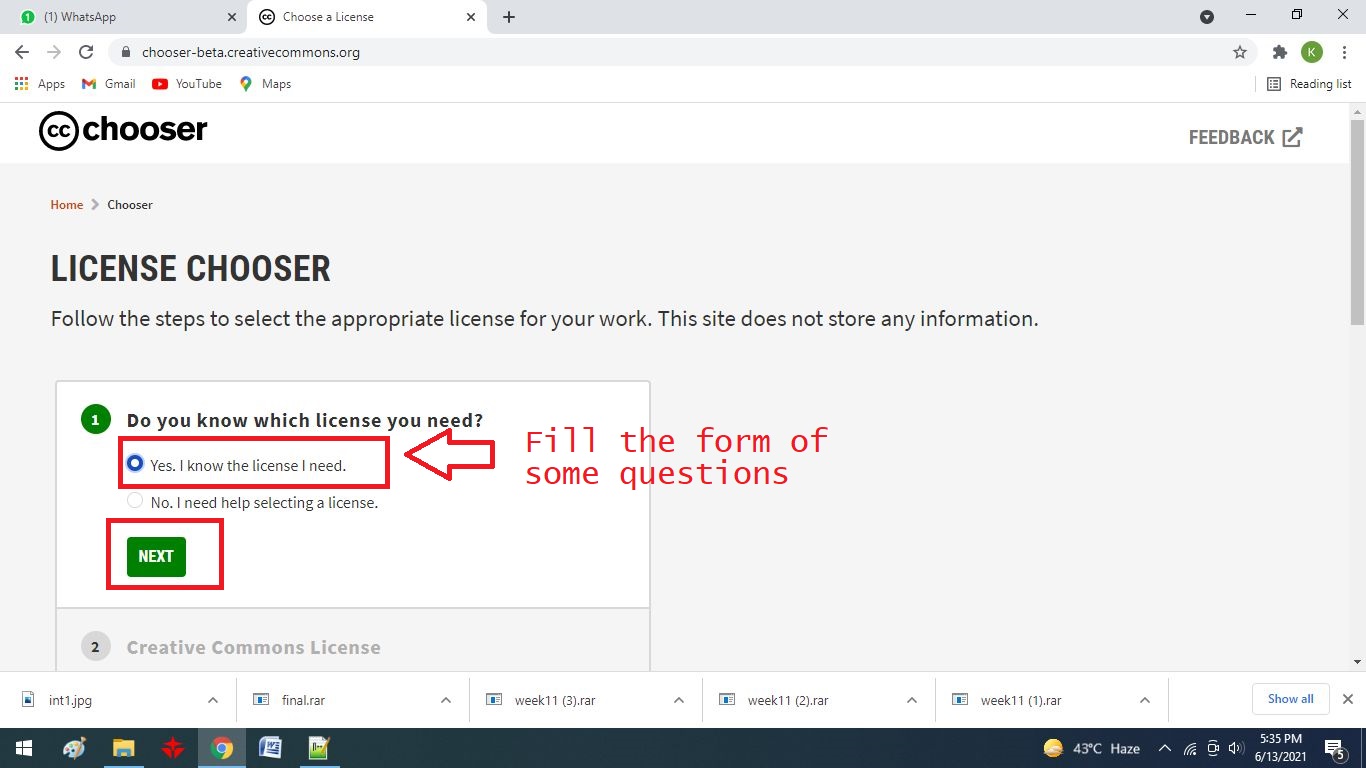
Select the highlighted answer.
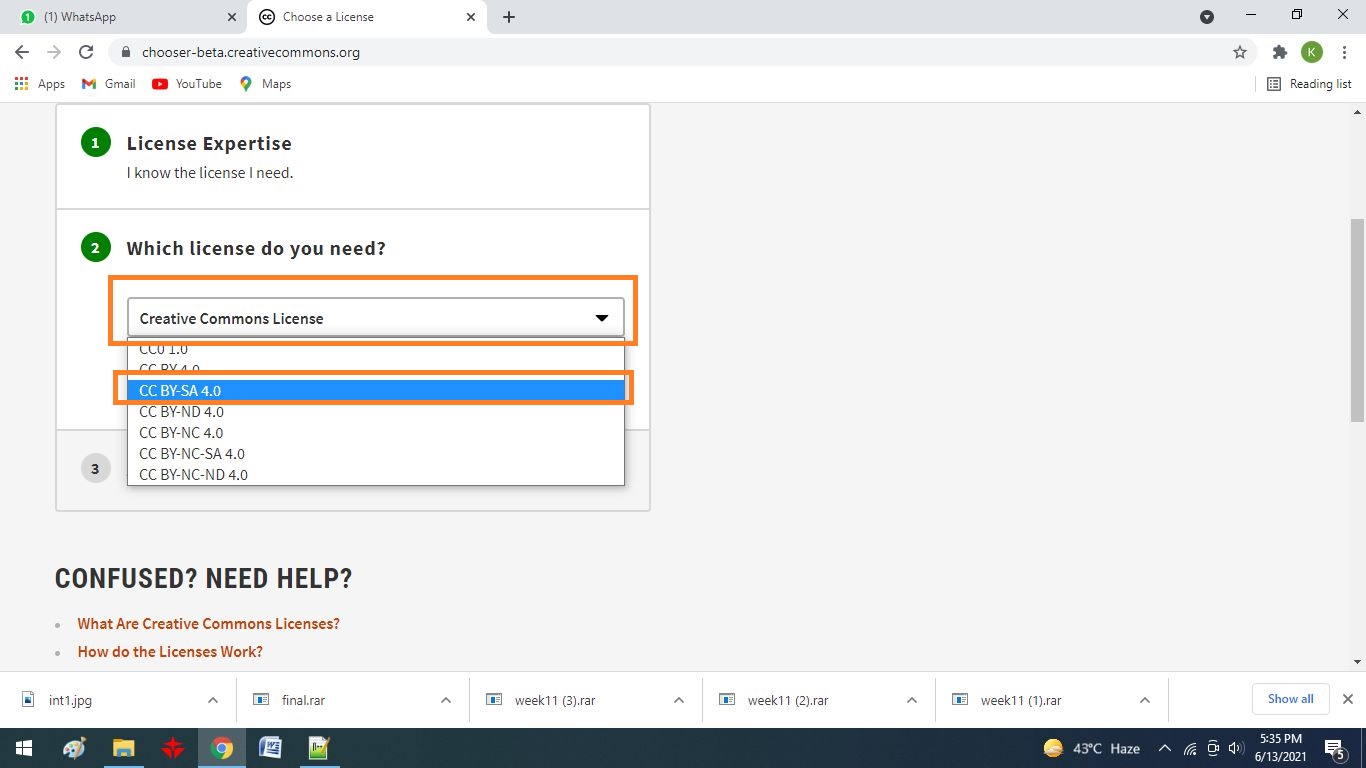
Select the highlighted answer.
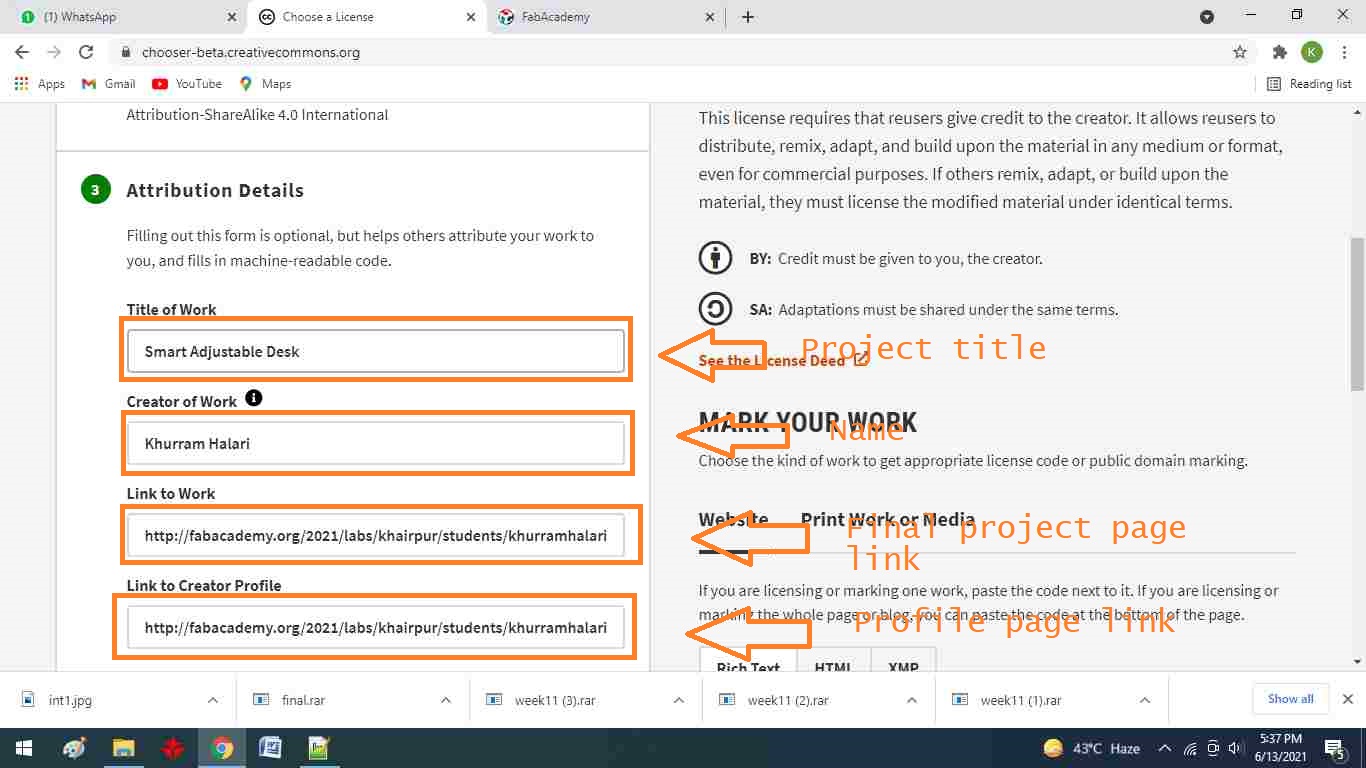
Share information about the project in this icon.
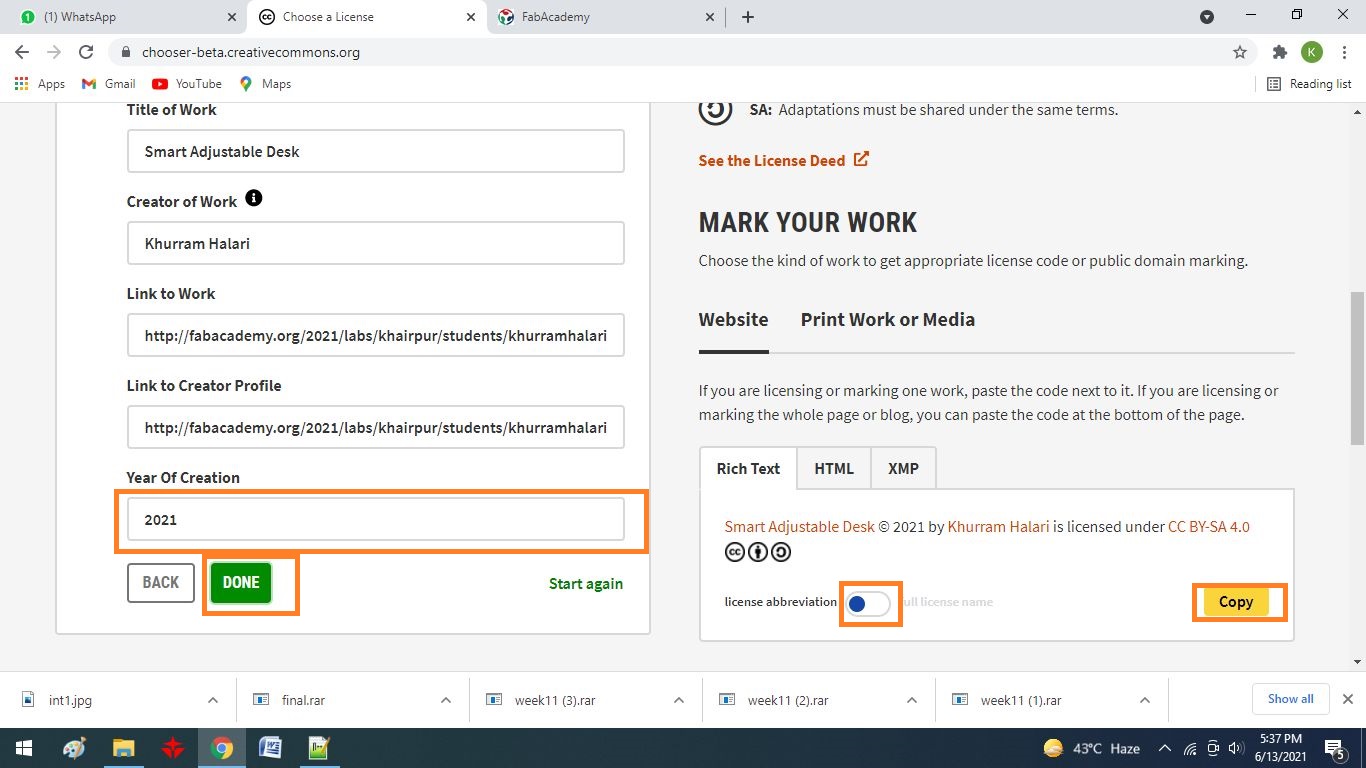
Click on the done button.
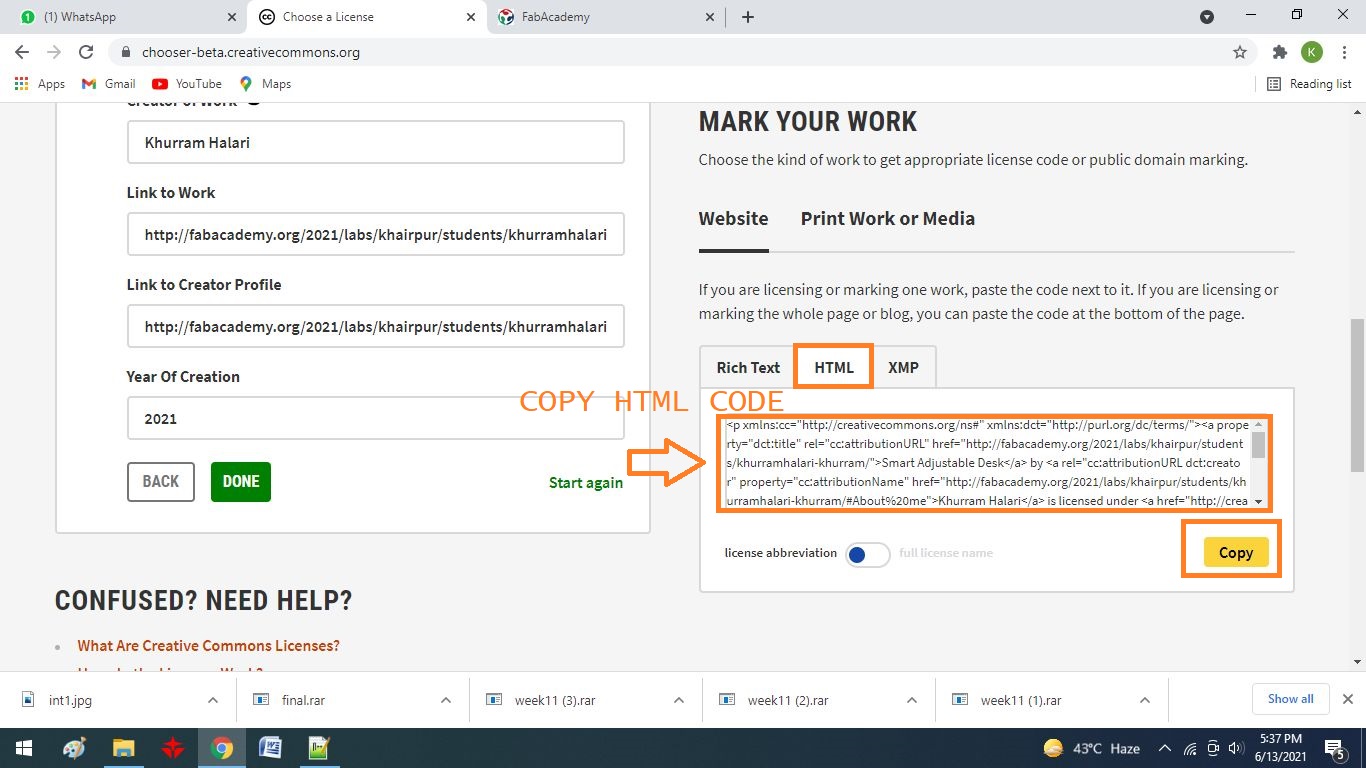
The Final part is to copy the embedded code on to the website
The following icon shows under what terms my project is licensed.
Plan for Dissemination
Knowledge is actually meant to be shared, we keeps on growing by sharing and gaining knowledge continuously, it not only help the other person to improve but polishes our skills as well.The project is going to be an open source non-commercial project. The project is still prototype and need time to make it more furnished to be as product.
To launch this product commercially, I have to introduce my project to different Restaurants, Universities, homes and shops. The project need a marketing team to work for sale this product.
Final Project Slide

Final Project Video
SMART ADJUSTABLE DESK by KHURRAM HALARI is licensed under Attribution-ShareAlike 4.0 International